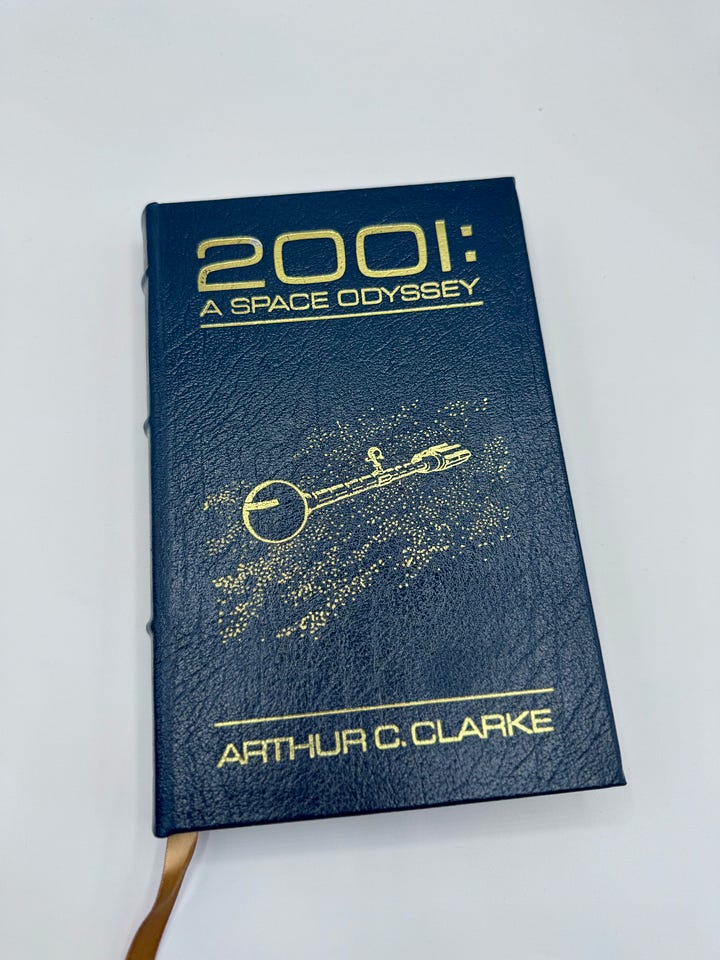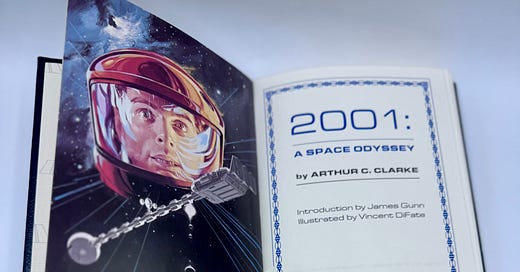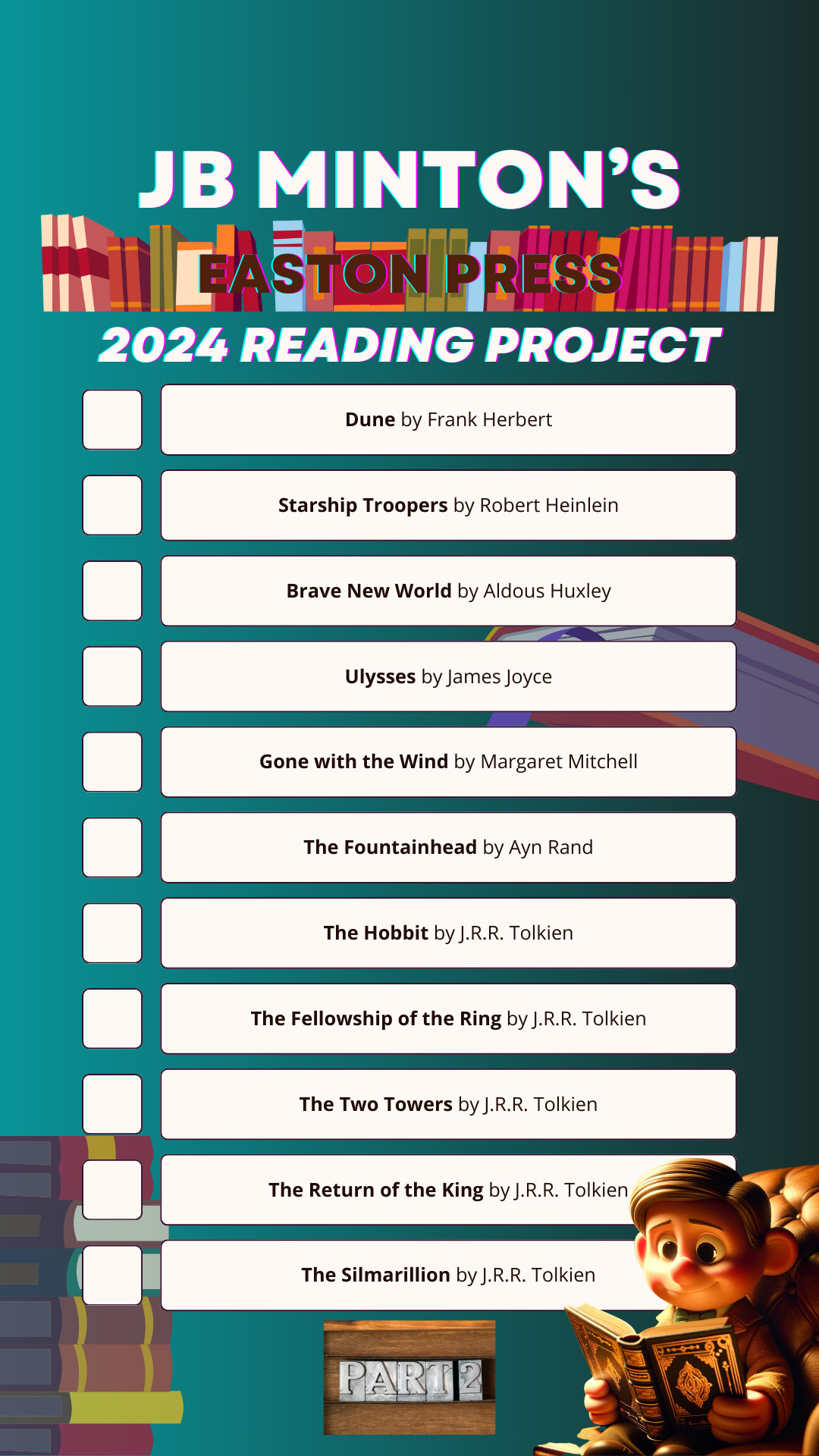“My God, It’s Full Of Stars…” '2001: A Space Odyssey by Arthur C. Clarke
Volume 2: “Reading Through My Easton Press Fiction Collection in 2024”


About the Book
Published in 1968, 2001: A Space Odyssey was written by one of the greatest minds ever produced by the human species, Arthur C. Clarke. The novel resulted from a collaboration with one of the great filmmakers, Stanley Kubrick, but it began as a short story called The Sentinel.
What Happens?
If you know what happens in this story because you’ve fallen asleep a few times through the music-laden, dialogue-light film, you should prepare for the novel to reinvent what you’ve seen on screen.
This story is a journey of the mind and an origin tale of the human spirit, as well as a physical and meta-physical adventure that leads to the eschewing of the human weakness of war for profit and control. All of that happens in this book while we also explore the emotional limitations of Artificial Intelligence to hold a lie and act in opposition to the truth. This situation with AI is something we are dealing with in both our technology and human spiritual challenges of modern times.
Millions of years before human space travel, at the end of a ten-million-year drought, early hominids scraped the Earth for berries and roots to survive. They are prey to the large cats. They live in fear and hunger. They die young of old age. Until one day, a strange black object appears. They do not understand that the dimensions are three perfect square roots of the first three numbers that have yet to be invented = 1 X 4 X 9.
But their ancestors will know. Touching the Monolith changes these proto-humans. And when they touch it, strange visions and dreams come to them, images that conceptually connect into recognized Laws of Nature. Eventually, one picks up a bone and discovers the physics of murder. From there, it’s a quest for more powerful weaponry to master the environment and food supply and destroy the other ape-men enemies who would take that food and the women for themselves. And so on for millions of years until we invented rallies for criminal dictators.
A grand experiment began that eventually led to human beings discovering another anomaly buried thirty feet deep in the moon dust, millions of years before Human Beings walked the planet. When the second Monolith is exposed to the light of the Sun for the first time in thirty million years, a ringing beacon calls out to the planet Saturn. It thus begins the most extraordinary odyssey in Human history.
A year after the beacon rings out, a human-crewed vessel navigates the deep space between the inner planets on the way to Saturn by slingshotting around Jupiter. The ship includes several Humans in hibernation, two lead Astronauts, and a pervasive AI named HAL (short for Heuristic Algorithm). HAL controls nearly all aspects of the mission and the vessel’s operation. But HAL also knows the deep secret of the Monolith and the nature of what is likely a one-way mission. As powerful and knowledgeable as HAL is, its creators have entrusted this machine with a secret mission that tears its simple mind apart. Humans are the only creatures that can know the lie and still live as if the lie were untrue. Perhaps this cognitive dissonance was a final parting gift from that Monolith long ago.
HAL cracks up and tries to sever the connection with Earth to reveal the truth to his companions. HAL ends up killing all but one human. That human is forced to kill HAL and severely limit his chances of success and survival.
What happens from here is a metaphysical journey that explores the nature of time, the human spirit, and the evolution of what we may become. The book ends with a large baby named “Star-Child,” the end product of the experiment that began so long ago when the first hominid placed their hands on that strange black Monolith.
Star-Child is a God. It has control of all nuclear weapons on the planet and detonates them simultaneously without harm to any life. The story ends with a new covenant for a world no longer founded on war as the mechanism of Human society.
Why does this book matter?
The novel 2001: A Space Odyssey is arguably the most mind-expanding narrative ever published. It certainly changed my life because, like those early ape-like ancestors who put their hands on the Monolith, I was different after reading this book in my youth. It has changed me again in my middle age.
The author of this short book was a Scientist first and a storyteller second. But it was a close second. When you read this novel, you learn to see the outside world as a kind, patient Scientist sees the world. Clarke’s descriptions of celestial phenomena from the point of view of an imagined observer are themselves an education. The way he describes shadows and colors on objects in space is equal to his descriptions and explorations of the most profound fear and the highest hopes of our cruel, feeble, and yet somehow redeemed species.
This book is for those who want to be religious but have never found the text that unlocks their hearts the way penitent believers go down on their knees before altars in churches built to hold collection plates.
Who would like this book?
Science Fiction Aficionados: If you’re a fan of mind-bending sci-fi that blurs the line between human and machine, this one’s for you.
Film Enthusiasts: Stanley Kubrick’s iconic film adaptation is a must-watch, and reading the source material adds a new dimension. However, in this author’s opinion, the film is inferior to the novel in storytelling. The movie cuts out so much of the last act that it is nearly limp. Reading the book before watching the film creates a more enjoyable and meaningful experience.
2001 sequel seekers dive into the rest of Clarke’s Space Odyssey series for even more cosmic adventures.
Fans of Philosophical Sci-Fi: If you enjoy pondering the big questions of life, the universe, and everything else, this book will keep you pondering for days.
About Easton Press & Their Books
Established in 1958, Easton Press is a renowned American publishing company known for its exquisite, leather-bound books, specializing in producing collector's editions of classic literature, history, science, and other notable works.
Easton Press books feature premium leather covers that are hand-selected for quality and durability. These covers are often adorned with intricate embossing, 22-karat gold accents, and elegant gilded page edges.
Every Easton Press book boasts a Smyth-sewn binding, meticulously crafted to ensure durability and longevity. This binding technique allows the book to lay flat and open smoothly, preserving the integrity of the text and illustrations.
THE JB MINTON NEWSLETTER
“PAY WHAT YOU CAN” Menu of Options
$40 Annual Subscription⬇️(suggested)
Can’t afford any of these tiers? No problem. Share the JB Minton Newsletter with your network and enjoy free Premium access when they subscribe for free or paid plans.
1 Referral = 1 Month of Paid Access
5 Referrals = 6 Months of Paid Access
10 Referrals = 1 Year of Paid Access
Use this button to get started ⬇️










